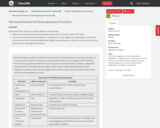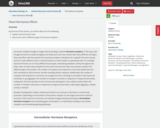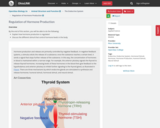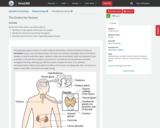
- Material Type:
- Full Course
- Provider:
- Rice University
- Provider Set:
- OpenStax College
- Date Added:
- 03/07/2018



By the end of this section, you will be able to do the following:
Explain how hormonal cues help the kidneys synchronize the osmotic needs of the body
Describe how hormones like epinephrine, norepinephrine, renin-angiotensin, aldosterone, anti-diuretic hormone, and atrial natriuretic peptide help regulate waste elimination, maintain correct osmolarity, and perform other osmoregulatory functions

By the end of this section, you will be able to do the following:
Describe the role of different glands in the endocrine system
Explain how the different glands work together to maintain homeostasis

By the end of this section, you will be able to do the following:
Explain how hormones work
Discuss the role of different types of hormone receptors

By the end of this section, you will be able to do the following:
Explain how hormones regulate the excretory system
Discuss the role of hormones in the reproductive system
Describe how hormones regulate metabolism
Explain the role of hormones in different diseases

By the end of this section, you will be able to do the following:
Explain how hormone production is regulated
Discuss the different stimuli that control hormone levels in the body

By the end of this section, you will be able to do the following:
List the different types of hormones
Explain their role in maintaining homeostasis


By the end of this section, you will be able to do the following:
Describe four types of signaling mechanisms found in multicellular organisms
Compare internal receptors with cell-surface receptors
Recognize the relationship between a ligand’s structure and its mechanism of action


By the end of this section, you will be able to do the following:
Describe the functions proteins perform in the cell and in tissues
Discuss the relationship between amino acids and proteins
Explain the four levels of protein organization
Describe the ways in which protein shape and function are linked



By the end of this section, you will be able to:
Identify the major glands of the endocrine system
Identify the hormones secreted by each gland
Describe each hormone’s role in regulating bodily functions